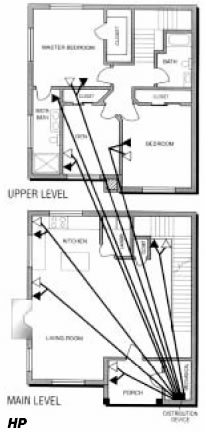May 2001
'Star' Wiring Hits a Home Run
By the end of 2002, some 30 million U.S. households will have two or more personal computers. If you think that number may include you, perhaps you should start thinking about installing a home wiring network to serve your growing needs.
"Fifty years ago most homes had one phone," says Mickey Arnold, president of Arnold and Shadwick Consulting, a computer network installation firm in Chattanooga, Tennessee. "When multiple phones became common, you needed a phone network. It's the same today with computers and televisions."
Just as homes are moving beyond the one-phone, one-television, one-computer stage, so is a home's wiring requirements. New homes today are being built-and older homes retrofitted-with "structured" wiring systems that have the capacity to handle digital high-speed voice, data, audio and video signals. Equally important is the way the wiring is installed. All wires must be installed in "home runs"-also known as a "star" wiring pattern-directly from each outlet to a distribution device, or hub. "If you hold up your hand, each finger is a home run," explains Arnold. "Your palm is the hub.
"  At issue is the need for wiring bandwidth, or communications-carrying capacity. Plain old telephone wire has sufficient bandwidth for voice traffic, but when you plug a computer modem into it, transmissions become ponderously slow-especially when loading Web pages or complex graphic programs. This problem can only get worse. Experts predict that high-speed Internet services, interactive T V and other applications will increase residential bandwidth requirements by orders of magnitude.
At issue is the need for wiring bandwidth, or communications-carrying capacity. Plain old telephone wire has sufficient bandwidth for voice traffic, but when you plug a computer modem into it, transmissions become ponderously slow-especially when loading Web pages or complex graphic programs. This problem can only get worse. Experts predict that high-speed Internet services, interactive T V and other applications will increase residential bandwidth requirements by orders of magnitude.
The Telecommunications Industry Association has specified a minimum standard structured wiring package, called T I A 570A, that is expected to meet home networking demands well into the future. The TIA recommends Category 5 (or better) four-pair copper wiring for telephones, computer networks, lighting controls and other low-voltage uses, along with "quadshielded" RG-6 coaxial cable for video. All are connected to a central distribution box-much like a home's electrical service panel.
Installing structured wiring is not difficult, but it is less error-tolerant than oldstyle telephone wire. For instance, in addition to the star installation requirement, splices must not be made along a wiring run because they reduce the available bandwidth. Other errors to avoid include crimping, crushing or bending the wire too sharply, using metal staples to fasten it, running it too close to electrical wire or fluorescent lights, or even pulling it too hard during installation. Such stresses severely limit structured wiring's ability to carry high-speed communications signals.
To avoid these problems, it's important to hire an experienced installer. Trained professionals understand structured wiring and will take the proper steps to protect it. One problem homeowners face in this fast-growing market, however, is that many tradesmen lack the training needed to install structured wiring properly, and there are still too few residential telecommunications experts available.
Information on structured wiring, standards and installation is available online through Wiring Americas' Homes, an industry group formed to promote advanced telecommunications wiring. Many of the suppliers, listed on the group's Web site, also have national networks of installers.
